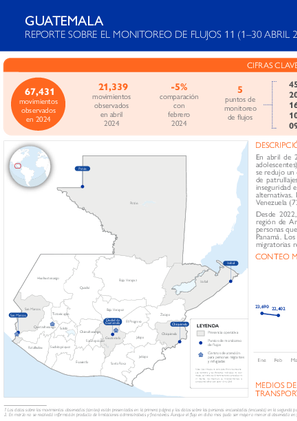-
Countries
-
Data and Analysis
-
Special Focus
-
Crisis Responses
Flow Monitoring

Contact
Idiam Osorio, iosorio@iom.int
Language
English
Location
Panama
Period Covered
May 01 2024
May 26 2024
Activity
- Flow Monitoring Survey
- Flow Monitoring
The province of Darien is located on the eastern border of Panama and its territory is one of the migratory crossings most used by people on the move through the Americas, from the south to the north of the continent. This crossing is highly dangerous due to the geographical characteristics of the Darien National Park and the presence of organized crime. People who transit it are exposed to various risks such as human trafcking, smuggling, gender-based violence, various forms of exploitation and abuse. The use of these unsafe crossings to reach temporary or fnal destinations poses threats to the integrity, dignity, and lives of migrants.
Currently, Panama maintains the Operation Controlled Flow active, which provides humanitarian assistance and transfers hundreds of migrants daily from the Temporary Migrant Reception Centres (hereinafter, ETRM) in the province of Darien to the Temporary Attention Centre for Migrants (CATEM) in Costa Rica. The migrants enter through the communities of Bajo Chiquito and Canaan Membrillo, located in the Embera-Wounaan indigenous region in the interior of the province of Darien in Panama, and are transferred respectively to the diferent ETRMs.
Between 1 and 26 May 2024, 25,761 migrants were registered entering irregularly through the Darien jungle, representing an average of 954 daily entries. In April 2024, the total number of entries was 29,259, a decrease of 12 per cent compared to the previous month.
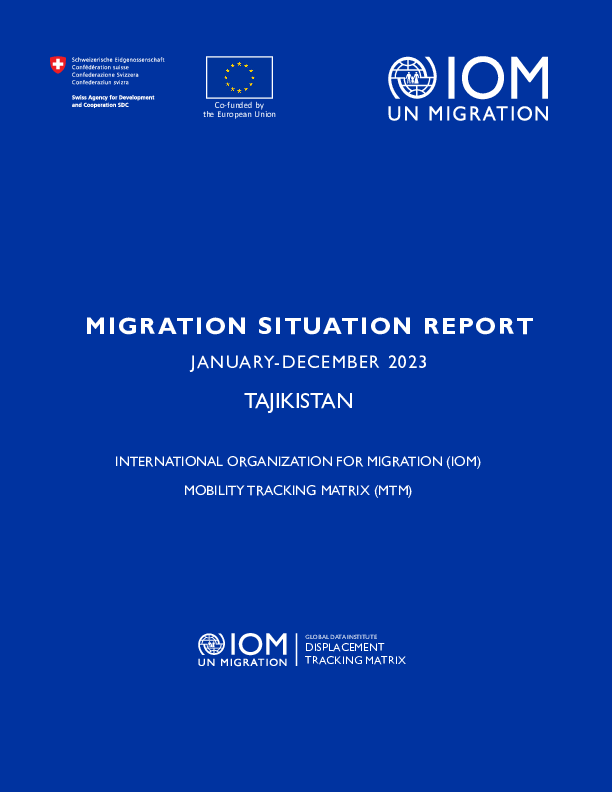
Contact
Contact mtmTajikistan@iom.int
Language
English
Location
Tajikistan
Period Covered
Jan 01 2023
Dec 31 2023
Activity
- Flow Monitoring
- Mobility Tracking
The report aims to provide an overview of the migration patterns and mobility in Tajikistan, drawing upon data from the latest available sources until the end of 2023 from national and international datasets on migratory movements concentrating on the most recent migration situation in Tajikistan. This includes migration flow, number of residences permits and remittances, as well as reasons for migration. The report includes the continuing impact of the Russian invasion of Ukraine on traditional migration corridors in the region, changing labour migration flows, increase of climate change and migration concerns, the growing urbanization process, the social-economic circumstances, and other major events are described as main contributing factors of the human mobility and migratory movements in the given period in the country.
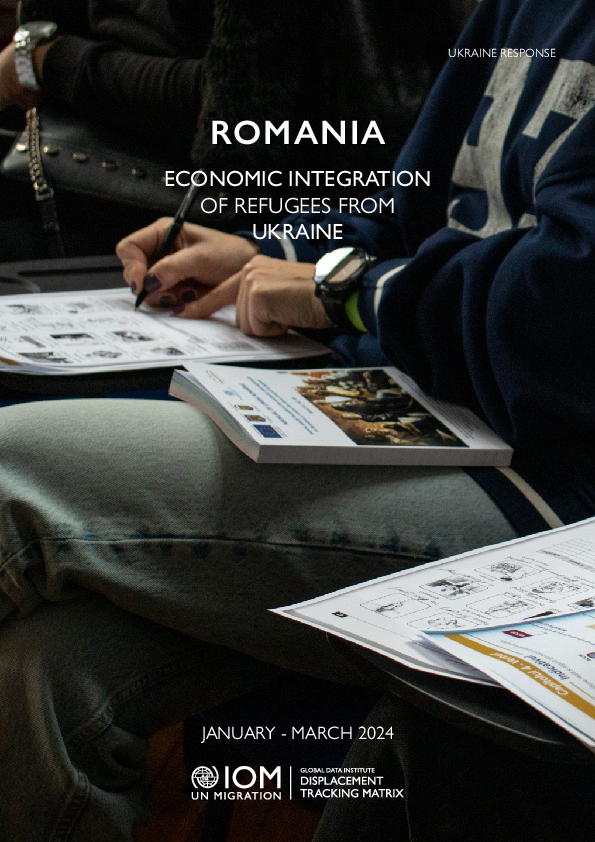
Contact
DTM Europe, DTMMediterranean@iom.int
Language
English
Location
Romania
Period Covered
Jan 01 2024
Mar 31 2024
Activity
- Survey
- Flow Monitoring
IOM’s Displacement Tracking Matrix (DTM) collected data through Surveys with Refugees in the Ukraine Response region from January to March 2024. This report focuses on the economic integration of the Ukrainian nationals residing in Romania since the start of the war in February 2022. The survey reported on the situation of 436 interviewed Ukrainian nationals, with a focus on the respondents of working age (18-64 years old).
Key findings:
- 60% of respondents were active in the labour market, while 35% were inactive and 5% were unknown
- Within the active population, 65% were employed and 35% were unemployed and looking for a job
- Most respondents utilised their personal network to find employment (43%). Others utilised: recruitment agencies (19%), social media (14%), job portals (11%).
- 43% of respondents had neutral feelings towards their job satisfaction
- Majority of respondents identified no problems at work (51%). For those who did, the main problems included: being underpaid (4%), having no contract (4%), working long hours (4%), and no breaks (3%).
- Top 3 sources for paying expenses included: family support (46%), income (41%), and savings (35%).

Contact
DTM Europe, DTMMediterranean@iom.int
Language
Estonian
Location
Estonia
Period Covered
Mar 01 2023
Dec 31 2023
Activity
- Survey
- Flow Monitoring
IOMi sundrände jälgimise maatriks on regulaarselt küsitlenud inimesi, kes elavad 11 riigis, mida hõlmab Ukraina piirkondliku pagulasküsimuse tegevuskava. Küsitluse eesmärk on parandada arusaamist nende profiilidest, sundrändemustritest, kavatsustest ja vajadustest. Küsitlust tehakse kuues Ukraina naaberriigis –Valgevenes, Ungaris, Poolas, Moldova Vabariigis, Rumeenias ja Slovakkias –ning viies teises Euroopa riigis, mida Ukrainast pärit pagulaste saabumine alates sõja algusest 2022. aasta veebruaris iseäranis mõjutab, sealhulgas Bulgaarias, Tšehhis, Eestis, Lätis ja Leedus.
Käesolevas aruandes esitatud analüüs põhineb 2023. aasta märtsist detsembrini kogutud iga-aastastel andmetel.
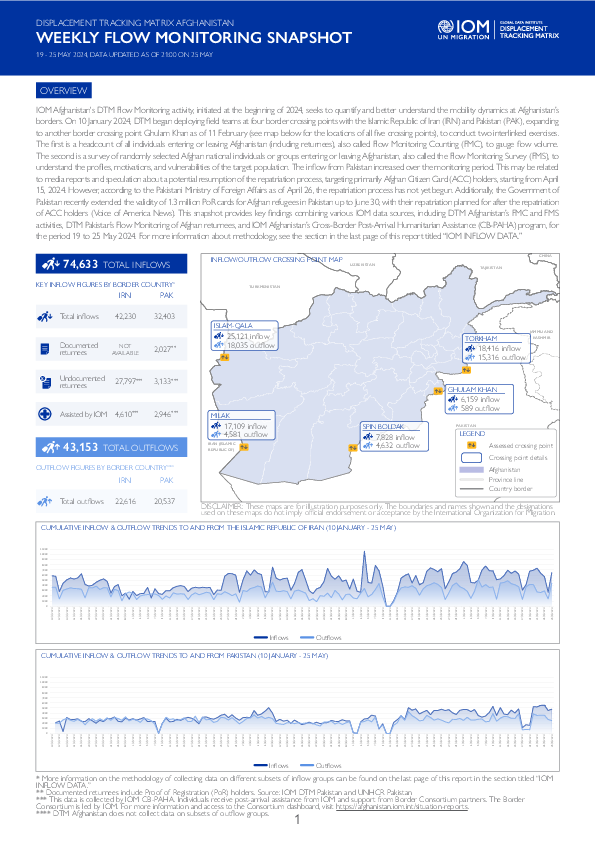
Contact
DTMAfghanistan@iom.int
Language
English
Location
Afghanistan
Period Covered
May 19 2024
May 25 2024
Activity
- Survey
- Flow Monitoring Survey
- Flow Monitoring
IOM Afghanistan's DTM Flow Monitoring activity, initiated at the beginning of 2024, seeks to quantify and better understand the mobility dynamics at Afghanistan’s borders. On 10 January 2024, DTM began deploying field teams at four border crossing points with the Islamic Republic of Iran (IRN) and Pakistan (PAK), expanding to another border crossing point Ghulam Khan as of 11 February (see map below for the locations of all five crossing points), to conduct two interlinked exercises. The first is a headcount of all individuals entering or leaving Afghanistan (including returnees), also called Flow Monitoring Counting (FMC), to gauge flow volume. The second is a survey of randomly selected Afghan national individuals or groups entering or leaving Afghanistan, also called the Flow Monitoring Survey (FMS), to understand the profiles, motivations, and vulnerabilities of the target population. The inflow from Pakistan increased over the monitoring period. This may be related to media reports and speculation about a potential resumption of the repatriation process, targeting primarily Afghan Citizen Card (ACC) holders, starting from April 15, 2024. However, according to the Pakistani Ministry of Foreign Affairs as of April 26, the repatriation process has not yet begun. Additionally, the Government of Pakistan recently extended the validity of 1.3 million PoR cards for Afghan refugees in Pakistan up to June 30, with their repatriation planned for after the repatriation of ACC holders (Voice of America News). This snapshot provides key findings combining various IOM data sources, including DTM Afghanistan’s FMC and FMS activities, DTM Pakistan’s Flow Monitoring of Afghan returnees, and IOM Afghanistan’s Cross-Border Post-Arrival Humanitarian Assistance (CB-PAHA) program, for the period 19 to 25 May 2024. For more information about methodology, see the section in the last page of this report titled “IOM INFLOW DATA.”
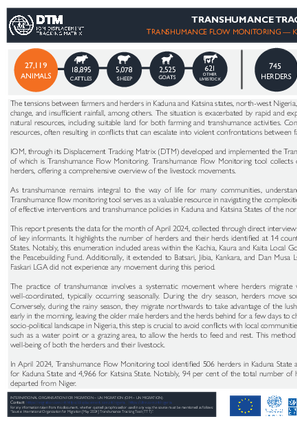
Contact
DTM Nigeria, iomnigeriadtm@iom.int
Language
English
Location
Nigeria
Period Covered
Apr 01 2024
Apr 30 2024
Activity
- Flow Monitoring
This report presents the data for the month of April 2024, collected through direct interviews and direct observation by DTM enumerators and triangulated via a network of key informants. It highlights the number of herders and their herds identified at 14 counting points in 7 Local Government Areas (LGAs) across Kaduna and Katsina States. Notably, this enumeration included areas within the Kachia, Kaura and Kaita Local Government Areas (LGAs) of Kaduna and Katsina states, under the auspices of the Peacebuilding Fund. Additionally, it extended to Batsari, Jibia, Kankara, and Dan Musa LGAs of Katsina state, which were supported by the European Union Fund.
Faskari LGA did not experience any movement during this period.
In April 2024, Transhumance Flow Monitoring tool identified 506 herders in Kaduna State and 239 herders in Katsina State. The animal count was estimated at 22,153 for Kaduna State and 4,966 for Katsina State. Notably, 94 per cent of the total number of herders departed from states within Nigeria, while the remaining 6 per cent departed from Niger.
En abril de 2024 se observaron 21,339 movimientos en Guatemala (16% niños, niñas y adolescentes) y 394 personas fueron encuestadas.1 El número de movimientos observados se redujo un cinco por ciento desde febrero2 de 2024 (22,402). Esto producto del aumento de patrullajes a lo largo de la frontera entre México y Guatemala, así como una mayor inseguridad en algunas partes de Guatemala, lo que empuja a los migrantes a utilizar rutas alternativas. Más de la mitad de los movimientos procedía de la República Bolivariana de Venezuela (72%). El principal destino previsto fue los Estados Unidos de América (91%). Desde 2022, los flujos de migrantes en tránsito incrementaron significativamente en la región de América Latina y el Caribe, observando cantidades nunca antes registradas de personas que cruzan la peligrosa selva del Parque Nacional del Darién desde Colombia hacia Panamá. Los flujos en tránsito observados en Guatemala han reflejado dichas tendencias migratorias regionales.

Contact
iomguatemala@iom.int
Language
English
Location
Guatemala
Period Covered
Apr 01 2024
Apr 30 2024
Activity
- Flow Monitoring
In April 2024, 21,339 movements were observed in Guatemala (16% children) and 394 individuals were surveyed.1 The number of observed movements decreased by five per cent from February2 2024 (22,402). This is a result of the increase in patrols along the Mexico–Guatemala border as well as increased insecurity in some parts of Guatemala, pushing migrants to use alternative routes.More than half of movements originated from the Bolivarian Republic of Venezuela (72%). The main intended destination was the United States of America (91%). Since 2022, migratory flows through the Latin America and Caribbean region have increased significantly, with record levels of persons crossing the perilous jungle of the Darién National Park from Colombia into Panama. The in-transit flows tracked in Guatemala have mirrored these regional migration trends.
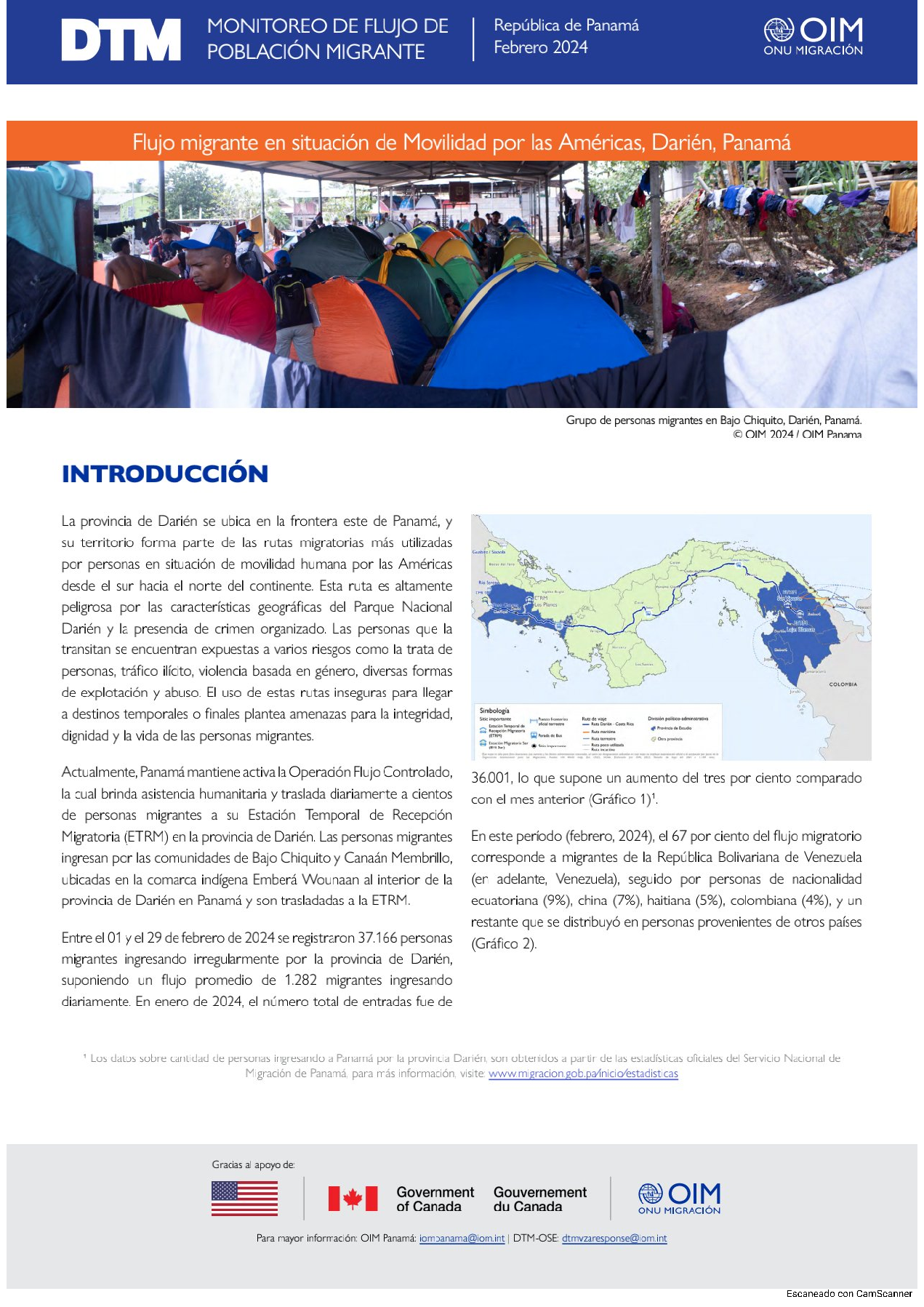
Contact
Idiam Osorio, iosorio@iom.int
Language
English
Location
Panama
Period Covered
Feb 01 2024
Feb 29 2024
Activity
- Flow Monitoring Survey
- Flow Monitoring
La provincia de Darién se ubica en la frontera este de Panamá, y su territorio forma parte de las rutas migratorias más utilizadas por personas en situación de movilidad humana por las Américas para migrar desde el sur hacia el norte del continente. A su vez, esta ruta es altamente peligrosa por las características geográficas del Parque Nacional Darién y la presencia de crimen organizado. Las personas que la transitan se encuentran expuestas a varios riesgos como la trata de personas, tráfico ilícito, violencia basada en género, diversas formas de explotación y abuso. El uso de estas rutas inseguras para llegar a destinos temporales o finales plantea amenazas para la integridad, dignidad y la vida de las personas migrantes.
Actualmente, Panamá mantiene activa la Operación Flujo Controlado, la cual brinda asistencia humanitaria y traslada diariamente a cientos de personas migrantes a sus Estaciones Temporales de Recepción Migratoria (ETRM) en la provincia de Darién. Las personas ingresan por las comunidades de Bajo Chiquito y Canaán Membrillo, ubicadas en la comarca indígena Emberá Wounaan al interior de la provincia de Darién en Panamá y son trasladadas respectivamente a las diferentes ETRM.
Entre el 01 y el 29 de febrero de 2024 se registraron 37.166 personas migrantes ingresando irregularmente por la provincia de Darién, suponiendo un flujo promedio de 1.282 migrantes ingresando diariamente. En enero de 2024, el número total de entradas fue de 36.001, lo que supone un aumento del tres por ciento comparado con el mes.
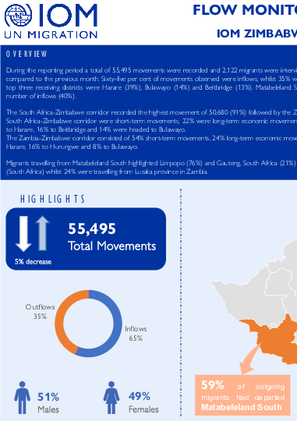
Contact
DTM Zimbabwe, DTMzimbabwe@iom.int, DTMsupport@iom.int
Language
English
Location
Zimbabwe
Period Covered
Apr 01 2024
Apr 30 2024
Activity
- Flow Monitoring
During the reporting period, a total of 55,495 movements were recorded and 2,122 migrants were interviewed across 20 Flow Monitoring Points (FMPs) in Zimbabwe. The total movements recorded decreased by 5% compared to the previous month. Sixty-five per cent of movements observed were inflows, whilst 35% were outflows. The top three sending districts were Beitbridge (59%), Harare (9%) and Chiredzi (9%), whilst the top three receiving districts were Harare (39%), Bulawayo (14%) and Beitbridge (13%). Matabeleland South province recorded the highest number of outflows (59%) whilst Harare province recorded the highest number of inflows (40%).
The South Africa-Zimbabwe corridor recorded the highest movement of 50,680 (91%) followed by the Zambia-Zimbabwe corridor which recorded 4,815 (9%) movements. Fifty-four per cent of movements along the South Africa-Zimbabwe corridor were short-term movements, 22% were long-term economic movements whilst 21% were family reunification movements. Of the migrants travelling from South Africa, 34% travelled to Harare, 16% to Beitbridge and 14% were headed to Bulawayo.
The Zambia-Zimbabwe corridor consisted of 54% short-term movements, 24% long-term economic movements and 21% family reunification movements. Of the migrants travelling from Zambia, 68% were travelling to Harare, 16% to Hurungwe and 8% to Bulawayo.
Migrants travelling from Matabeleland South highlighted Limpopo (76%) and Gauteng, South Africa (21%) as their intended destination. Of the incoming migrants travelling to Harare, 54% were travelling from Gauteng (South Africa) whilst 24% were travelling from Lusaka province in Zambia.
Pagination
- Previous page
- Page 8
- Next page
